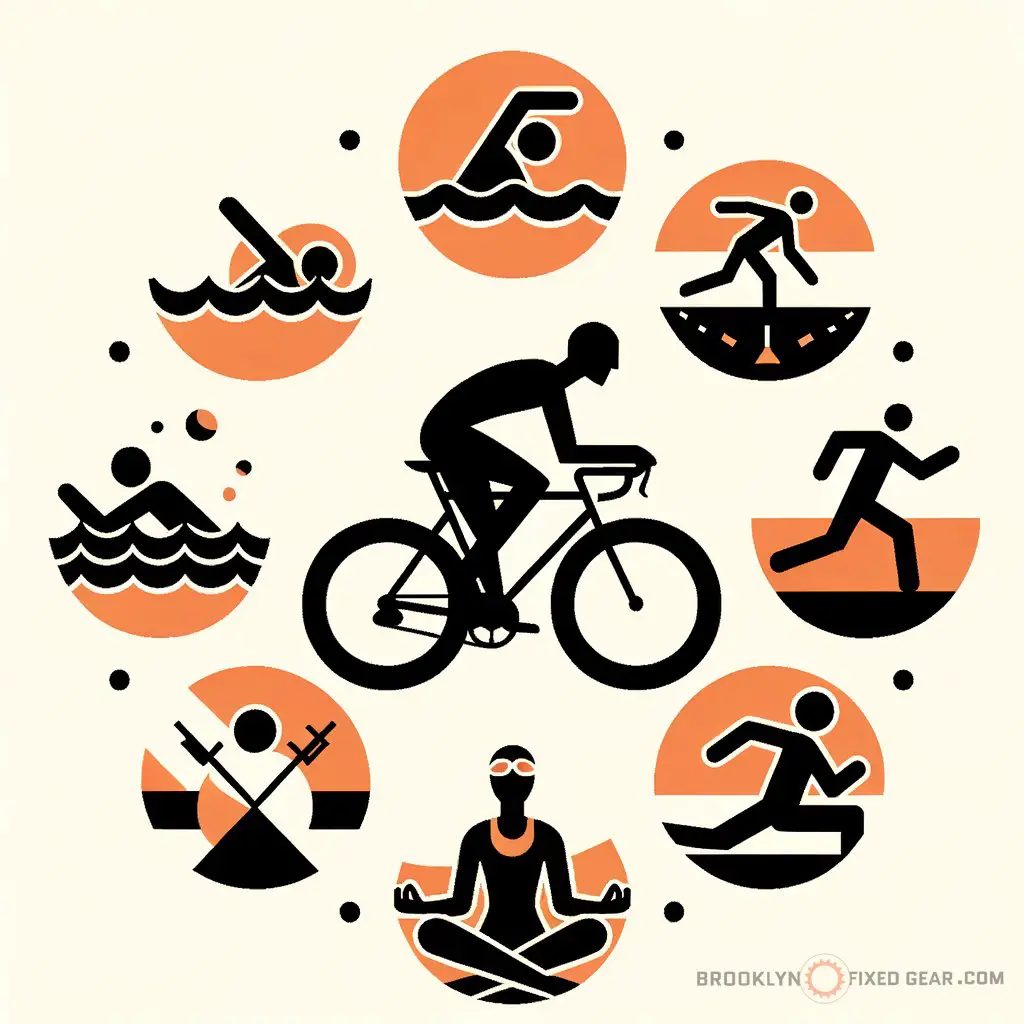Ever wondered how cross-training can boost your cycling game? Whether you’re a fan of speeding through city streets with a slick fixie under you or you just love to push your limits on a track bike, cross-training might be the key to stepping up your ride. Dive into the how and why of mixing it up can make a difference in your cycling performance.
Key takeaways
- Varied exercise boosts cycling performance and prevents injury.
- Include endurance and strength in your cross-training for maximum benefit.
- Track your progress to gauge cross-training effectiveness and adjust as needed.
Cross-Training effects on cycling
Cross-training has long been touted as a wonderful way to enhance overall athletic performance, but what does it really do for us die-hard cyclists? Well, first and foremost, it can prevent those all-too-common overuse injuries. When we obsess over our fixed-gears, we might forget that our bodies crave variety – that’s where cross-training swings in.

Here’s why mixing things up is a brilliant idea:
- It bolsters overall fitness, allowing you to ride longer and with more gusto.
- Certain exercises improve your core strength and stability, critical for maintaining the right posture on your bike.
- Cross-training can shake up your mental game, keeping burnout at bay and stoking the fires of motivation.
By adding activities like swimming, running, or even yoga, you’re giving muscles that aren’t typically engaged during cycling a chance to shine and support your main sport. This can lead to better endurance, power, and recovery. Toss in some neuromuscular training to fine-tune coordination and control—crucial for those tight urban corners or sprint finishes.
Alright, so here’s my two cents on the whole thing, but remember, I’m no fitness guru, just a guy who’s pretty stoked about fixed-gears and track bikes. In my book, adding a bit of cross-training to your routine is like slapping on a fresh set of drop bars—it changes your ride experience for the better. There’s this scene in the movie “Quicksilver” where Kevin Bacon’s character is doing all these other activities outside of biking, and it totally beefs up his cycling skills—or at least, it seems that way.
I once heard about a fixie rider who took up rock climbing to break up his routine. Dude said it worked wonders for his grip strength and endurance. Let’s face it, the usual grind can get monotonous.
Throw some cross-training into the mix, and you’ve got a recipe for a more balanced, robust rider. Plus, who knows, you might find a new passion while you’re at it. Check this out for ways to stay fit and prevent injuries.
State Bicycle Co. Black Label 6061

State Bicycle Co. Black Label 6061
Benefits of cross-training for cyclists
What is cross-training and how does it benefit cyclists?
Cross-training involves engaging in various forms of exercise aside from the primary sport of focus. For cyclists, it means complementing those long rides on your trusty track bike with other physical activities. It broadens your fitness base, which can lead to improved cycling performance and decreased risk of injury.

By engaging in different sports, cyclists can enhance muscular balance and endurance, thereby boosting their overall bike handling and power.
Which cross-training exercises are best for cyclists?
Picking the right cross-training exercises can be like finding the perfect bike saddle—comfort and fit are key. Endurance sports like swimming or running are fantastic as they build cardiovascular health without the high impact. Strength training, on the other hand, ramps up your muscle power, essential for those killer climbs.
And let’s not overlook flexibility-focused workouts like yoga or Pilates, which can prevent injuries and promote muscle recovery.
Cross-training routines
How can cyclists integrate cross-training into their routine?
The key is balance and not to overshadow the primary training focus. Gradually incorporate cross-training sessions into your weekly plan. Aim for one or two days a week, choosing activities that counterbalance cycling’s demands.
For example, if you’re all about leg day, every day, maybe give that upper body some love with rowing or resistance workouts.
Common challenges with cross-training for cyclists
Like tinkering with your fixie can lead to some common mistakes, there are potential pitfalls in cross-training as well. The biggest challenge for cyclists is usually finding the right mix and avoiding overtraining. Listening to your body is crucial—recovery is just as important as the workout itself.
Another challenge is ensuring that the cross-training complements cycling, rather than detracts from it, by selecting exercises that reinforce cycling muscles and skills.
Measuring improvements

Tracking progress and adaptability in cycling performance
To track improvements, keep a workout log detailing your cross-training exercises, duration, and how you feel afterward. Over time, you should see advancements in your cycling, like increased stamina and fewer injuries. If you’re not seeing the expected benefits, it may be time for a change.
Check out advanced riding techniques to shake things up.
Evaluating cross-training’s impact on competitive cycling
Competitive riders need to scrutinize their performance data meticulously. This could be lap times, heart rate variability, or power output. Cross-training’s impact can be subtle, showing up as improved recovery times between races or the ability to maintain a higher power output for longer durations.
Remember, your competition might be cross-training too, so every edge counts.
Cross-training is essential for cyclists looking to enhance their performance and safeguard against injuries. Here’s a breakdown of some core benefits:
| Benefit | Description |
|---|---|
| Injury Prevention | Reduces risk of overuse injuries by diversifying activities. |
| Muscle Balance | Promotes even muscular development. |
| Enhanced Endurance | Boosts cardiovascular fitness for longer, stronger rides. |
| Power Improvement | Strength training translates to more force on the pedals. |
| Mental Refreshment | Helps avoid burnout and keeps the mind engaged. |
Diversifying your workout routine with cross-training not only ramps up your cycling game but also keeps the burnout at bay. It’s all about enhancing those pedals with power, tackling longer rides, and dodging injuries with style.
cycling can be an exhilarating and physically demanding sport, which makes cross-training an invaluable part of a cyclist’s routine
More cross-training tips
Setting up a cross-training routine can give your cycling performance a serious boost. To make sure you’re getting the most out of it, here are some tailored tips to keep you in the saddle longer and with more power.
- Start cross-training during the off-season or when you’re not preparing for a race
- Incorporate exercises that mimic cycling movements for functional fitness
- Use cross-training to explore new physical activities that might interest you
- Set clear and measurable goals for your cross-training just as you would with cycling
- Schedule cross-training workouts on days when you’re not doing long rides to prevent fatigue
Before diving into cross-training, it’s smart to get a grip on the dos and don’ts to make the most of your efforts.
| Do | Don’t |
|---|---|
| Do diversify your workouts | Don’t neglect rest days |
| Do focus on endurance and strength | Don’t ignore proper form |
| Do track your progress | Don’t overdo it and risk injury |
| Do listen to your body’s cues | Don’t rush into high-intensity workouts |
Balancing cycling with alternative workouts provides diversity in training and contributes to overall athletic development
Advantages and disadvantages of cross-training
Cross-training, while revered by many athletes, brings with it a mixed bag of advantages and disadvantages. It’s crucial to weigh them against each other to ensure it fits into your cycling lifestyle effectively.
Advantages
- Improves overall fitness: Diverse activities enhance different physical capabilities.
- Reduces injury risk: Less repetitive strain on muscles used in cycling.
- Boosts mental health: A change in routine can prevent mental burnout.
- Enhances weight management: Different exercises can help control body weight.
- Increases flexibility and balance: Activities like yoga enhance core strength, which is beneficial for cycling posture.
Disadvantages
- Potential to overtrain if not managed correctly.
- Time-consuming to balance with cycling-specific training.
- Requires extra planning to incorporate effectively.
- Possibility of developing a preference for another sport, leading to less time on the bike.
- Can sometimes lead to suboptimal cycling performance if not tailored to support cycling-related muscles and energy systems.
If you are a visual learner, check out this video titled ‘Will Cross Training Make You a Faster Cyclist? The Science’
Frequently asked questions (FAQ)
How does cross-training affect bike handling skills?
Cross-training can notably impact bike handling skills by improving a rider’s overall balance, coordination, and functional strength. Adding activities that challenge these physical attributes can translate to more agile and confident bike handling, especially during technical rides or in challenging terrain.
Can cross-training help improve recovery times between cycling sessions?
Yes, cross-training can aid in faster recovery between cycling sessions. Engaging in low-impact, restorative activities, such as swimming or yoga, can enhance blood flow to tired muscles, helping to flush out toxins and reduce soreness, while also building strength and flexibility in non-cycling muscles.
Should beginners integrate cross-training into their cycling routine?
Beginners can greatly benefit from cross-training as it helps build a strong fitness foundation, which is critical when starting any sport. By adding it early, new cyclists can develop a more balanced physique, which can prevent overuse injuries and contribute to a more enjoyable and prolonged cycling journey.
Final thoughts
In wrapping up, cross-training stands out as a stellar strategy to elevate your cycling prowess. Whether you’re locked into the groove of your fixie’s rhythm or mastering the discipline of the track, supplementing cycling with alternative workouts can pay dividends in performance, enjoyment, and well-being.
Have you tried cross-training to improve your cycling skills? Did I cover everything you wanted to know? I read and reply to every comment. If you found this article helpful, share it with a friend, and check out my full blog for more tips and tricks on cycling strategies. Thanks for reading, and keep those gears turning!















